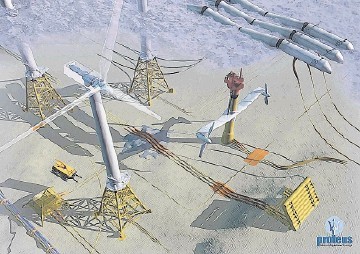
Power cable installation (mainly inter-array cables) is the problem child of the still putative offshore wind industry, which must learn from the huge experience of the offshore oil and gas industry, according to research by Enventi, a UK engineering design and consultancy firm.
While cabling accounts for around 2-3% of budgeted upfront capex, array cable installation is said by Enventi to be responsible for at least 75% of all insurance claims as a result of damage to cables.
“In fact, we think that array cable installation is nearer 5% of final capex once all associated costs are taken into account,” warns the consultancy.
Its report says that many of the problems being experienced are outside installation contractor control and relate to poor upfront design that shows a basic lack of operational know-how.
Main problems identified during cable installation are said to include:
o Poorly-designed interfaces between cables and related infrastructure (mainly turbines) resulting in highly weather sensitive operations requiring regular personnel transfers for each pull-in, with large amounts of vessel standby arising.
o Contracting philosophies used by utilities are based on civil contracting principles rather than a tried-and-tested off-shore approach. Contractors are, in some cases, being asked to accept liabilities and risk at higher levels than they would normally expect in other offshore industries such as oil and gas.
o Immaturity of contractors who lack relevant experience and/or a full-suite of burial equipment resulting in poorly-optimised lay and burial solutions.
o Arbitrary burial specified by clients with no link to what is realistic and achievable. Possibly originating from onshore cable depth standards.
o Basic lack of understanding of cable installation operations and technologies by clients. These problems, together with the lack of a regular pipeline of projects has resulted in a fragmented installation supply chain – for array installations at least. The report states that the demise of Subocean and OPU only reinforces this view.
Enventi’s general manager, Scott Macknocher, said of the findings. “Until now, we have found it difficult to understand why power cable installation appears to be the problem child of the offshore wind industry. especially given that it tends to be an established activity in other sectors, albeit with some well known challenges and risks.
“Our analysis appears to show that the majority of problems lie in the design of cable interfaces and the operating methodologies which are specific to offshore wind.
“These problems appear to have become accepted to such an extent that they have now become the norm.
“We don’t think that these problems are particularly difficult to overcome, however there seems to be a resistance to change.”
The report goes on to say of the oil and gas experience: “New entrants such as (subsea contractor) Technip should improve the supply chain, however how successful such top-tier installers from oil and gas will be remains to be seen given the radically different client base and their approach to contracting that exists in offshore wind compared to that in oil and gas.”
Enventi, with offices in Aberdeen and Cheltenham, says that the population of turbines offshore Europe currently has a capacity of some 3,000 megawatts (3GW) but that this would likely rocket to 25-30GW (gigawatts) by 2020.
Growth in associated cable installations will be significant, with an estimated 6,000km of export cable, 2,000km of EU inter-connector cable and 6,500km of array cable installations by 2020.
Windfarm export cable installation demand is forecast to more than triple from around 300km per year in 2011, to 800- 900km by the end of the decade.
We estimate that annual cable installation supply currently stands at around 600-650km for export cables and around 350km for array cables.
Identified capacity additions are quite limited, but we do sense an appetite for further investment into installation capacity before the middle of the decade.
Recommended for you
